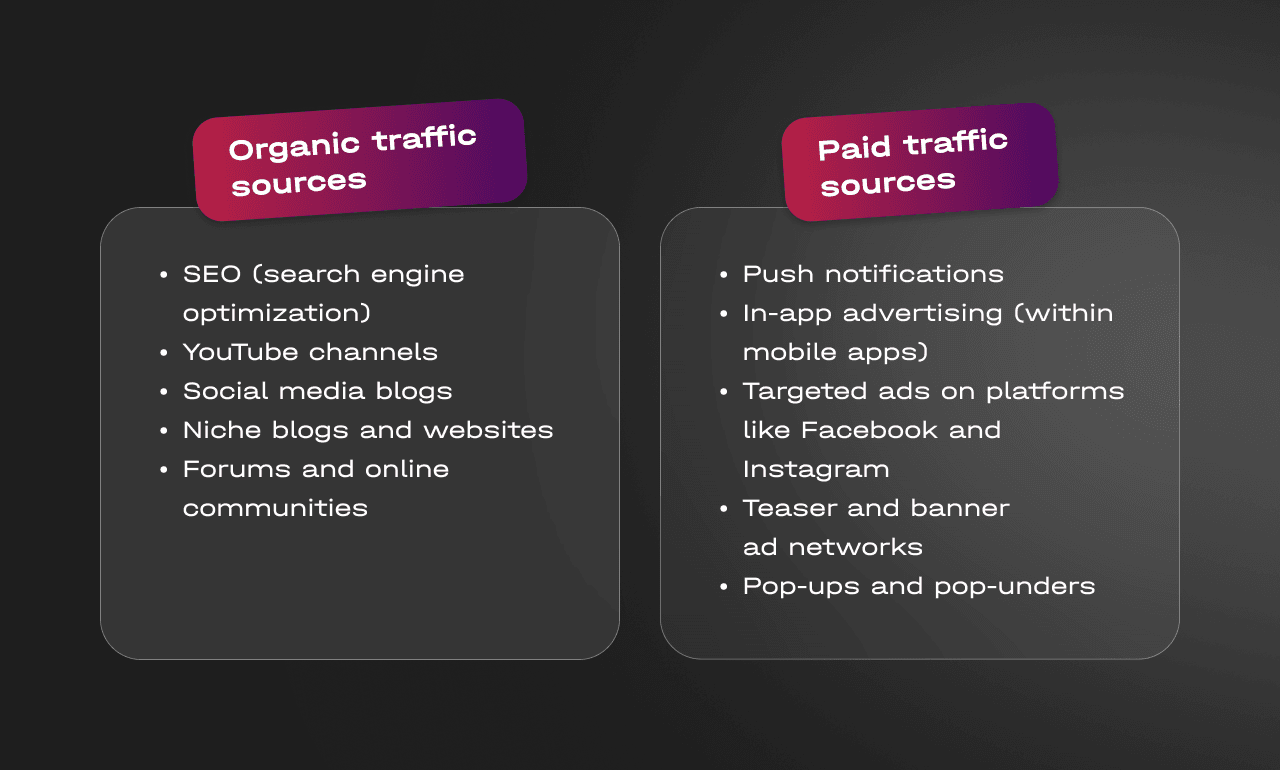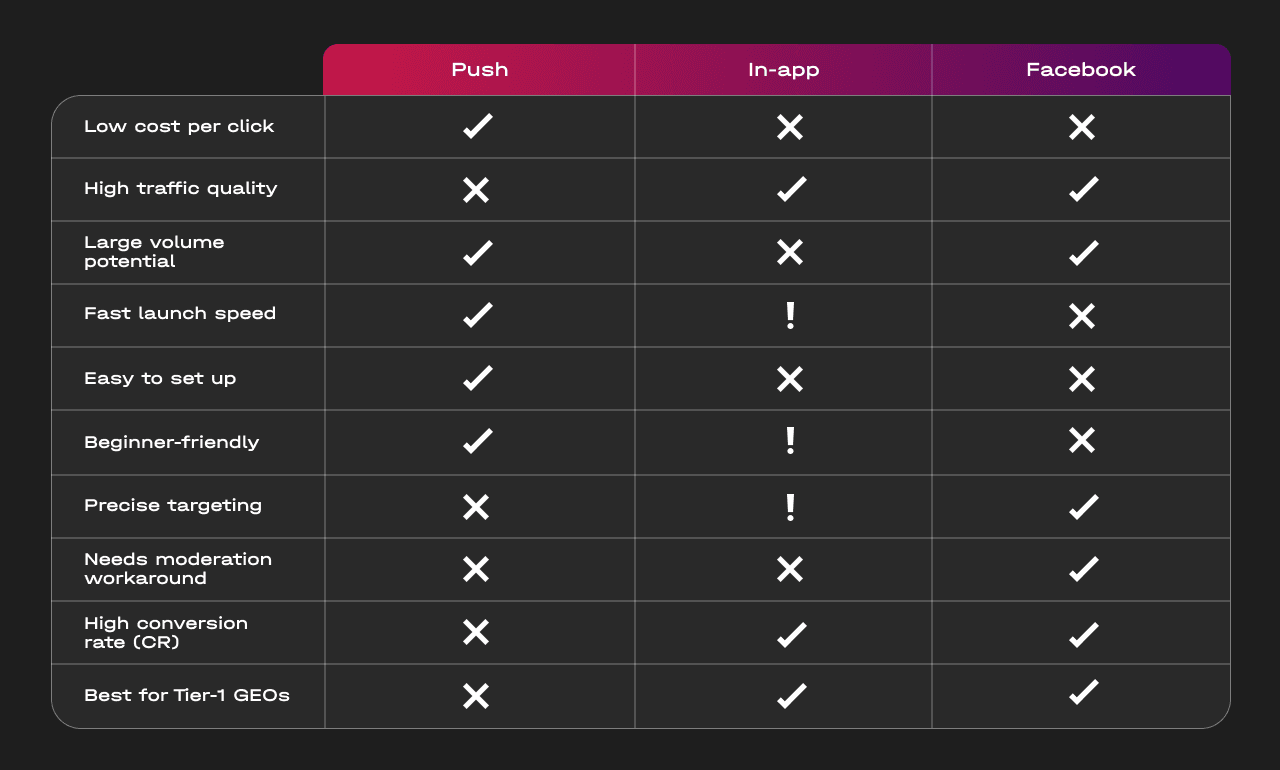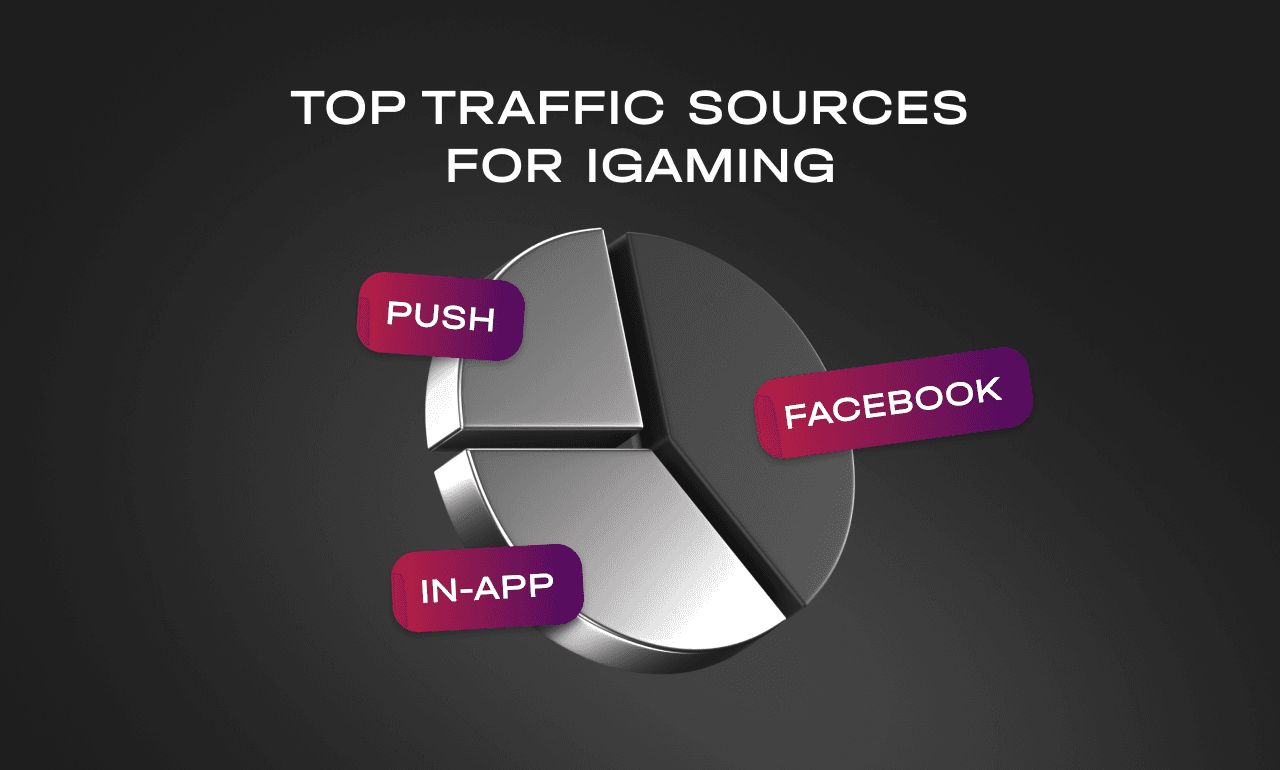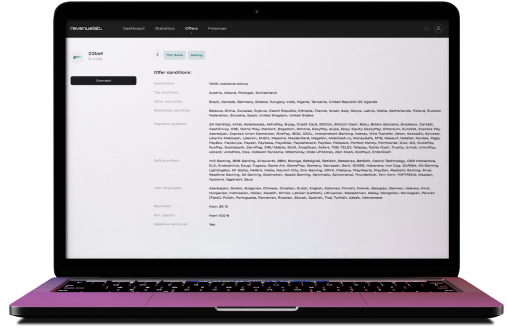In affiliate marketing, traffic means a flow of users you direct to a brand’s landing page. The more people you send, the better your chances of earning commission. But it’s not just about the number of clicks—quality matters even more. In iGaming, key traffic factors include:
So, top traffic sources fall into two categories: paid and organic (free).
Organic traffic comes from:
Affiliates often prefer organic traffic because it almost doesn’t require any budget and tends to attract a loyal audience. But building these channels takes time, effort, and consistency.
Paid traffic sources include:
Push notifications.
In-app advertising (within mobile apps).
Targeted ads on platforms like Facebook and Instagram.
Teaser and banner ad networks.
Pop-ups and pop-unders.
Affiliates choose paid traffic sources for their speed—you can test campaigns quickly and scale fast if a funnel performs well. The downside? You’re constantly spending money and risking budget loss if your campaign fails.
Working with iGaming traffic requires knowledge, precision, and caution. Ad platforms regularly update their policies, tighten moderation, and ban accounts without warning. Running successful campaigns means more than just turning on ads. You need to choose the right traffic source, align creatives with ad policies, fine-tune your funnel, and understand your target audience.
All the paid traffic sources behave differently. To earn consistent profit, you must test, analyze, and adapt. Knowing the strengths and limits of each option helps you reduce risk and boost results.
In this guide, we’ll show you how to buy quality traffic and which top traffic sources can bring in the highest commissions with the lowest ad spend.
Top traffic sources: how to buy traffic

Buying traffic isn’t just about topping up your ad account and launching the first campaign that comes to mind. If you want traffic that actually converts into registrations and deposits, you need a strategy of finding the best paid traffic sources for affiliate marketing.
Here’s a step-by-step guide to finding paid traffic sources that deliver:
1. Understand the offer’s rules and restrictions. Read the offer description carefully. Some affiliate programs prohibit specific traffic types, like Facebook Ads or incentivized traffic. Some require clean creatives, while others allow aggressive or clickbait-style ads. When in doubt, ask your affiliate manager.
2. Match the traffic to the offer type. Mobile offers (app installs, mobile registration flows) perform better through in-app ads, push, and teaser traffic. Web-based offers (casino landing pages, bonus promos) are usually more effective with Facebook, banner networks, or native ads. The best paid traffic sources for affiliate marketing require the best strategies.
3. Choose the right GEO strategy. Tier-1 countries (e.g. US, UK, Canada) demand high-quality traffic, often from platforms like Facebook or in-app ads. For Tier-2 and Tier-3 GEOs (e.g. LATAM, India, Eastern Europe), more aggressive and affordable sources like push or pop work well.
4. Check the traffic source Before investing a serious budget, research the platform. Look for feedback on Reddit, Trustpilot, or some related forums. If a traffic network is known for bots or fake clicks, it’s better to pay more for the best paid traffic sources for affiliate marketing.
5. Start small and test. Never pour your entire budget into a single campaign right away. Start with $20-50 per test, try multiple creatives and angles. Even a few conversions (FTDs) can show a working funnel worth scaling.
6. Track and analyze. Click numbers mean nothing on their own. Set up a tracker and monitor metrics like CR (conversion rate), ROI, session time, and deposit activity. A high click rate with zero registrations? Something’s wrong—either with the traffic or the funnel.
7. Optimize and scale. Once you’ve found a working setup, cut what doesn’t convert, double down on what does, and expand to new GEOs. Profitable traffic comes from smart testing, not guesswork.
Pro tip: Don’t rush. Take time to research platforms and test gradually. It’s better to move slow and steady than to blow your budget and walk away empty-handed.
The best paid traffic sources for affiliate marketing
Let’s break down the best traffic sources for affiliate marketing in iGaming. Here's our paid traffic sources list:
Push Traffic
Push traffic comes from browser or mobile push notifications — short messages that pop up on the user’s screen, even when the app or browser is closed.
Pros:
Very low CPC (starting from $0.001).
Instant campaign launch.
Targeting by GEO, device type, and time of day.
Cons:
Often lower quality — strong creatives are a must.
High bot percentage in cheap networks.
Not suitable for all types of offers.
When to use: Push is great for Tier-2 and Tier-3 GEOs when working with a limited budget. Ideal for fast-testing new funnels and driving traffic to offers with low entry barriers, such as registration bonuses or no-deposit promos.
In-App Advertising
In-app ads appear inside mobile apps — as banners, videos, or interactive placements. Users see them while playing games, reading news, or using utility apps.
Pros:
High-quality, real mobile users.
Strong engagement, especially with rewarded videos.
Available via DSPs with granular targeting.
Cons:
More expensive than push or teaser ads
Requires some technical experience to launch and optimize
Limited number of gambling-friendly networks
When to use: Best for promoting mobile casinos or betting apps, especially in Tier-1 and Tier-2 markets. Works well when your landing page is optimized for mobile devices and your goal is app installs or deep user engagement.
Facebook Ads
Facebook is one of the best traffic sources for affiliate marketing. It’s a powerful and flexible ad platform. It allows targeting based on interests, behaviors, location, age, device, and more. Campaigns can run on Facebook, Instagram, Messenger, and the Audience Network.
Pros:
Cons:
Strict moderation — gambling can’t be promoted directly.
Requires account farming, cloaking, and anti-detect tools.
High entry cost, especially in Tier-1 GEOs.
When to use: Perfect for experienced affiliates who know how to bypass moderation or build compliant white-hat funnels. Particularly effective in Tier-1 markets, where brand image and trust play a key role.
That was our paid traffic sources list. Use it to navigate affiliate marketing better than your competitors.
Which is the best traffic source for affiliate marketing?
The choice between push, in-app, and Facebook isn’t really about finding the best traffic source for affiliate marketing. It depends entirely on your goals, target GEOs, and level of experience. Each traffic source works differently — and each one can outperform the others in the right scenario.
Push is the simplest and most budget-friendly option. It delivers high volumes fast and is ideal for testing offers. However, engagement tends to be low — users often click out of curiosity, not real intent. That’s why push works best when testing new funnels or driving traffic to low-friction offers like no-deposit casino promos.
In-app delivers smaller volumes but better quality. It’s effective when your goal is deep engagement — users who not only click but also install and stick around. It costs more, but conversion rates can be higher, especially for mobile casino apps or live betting. If push is about volume, in-app is about precision.
Facebook is in a category of its own. It’s the only one of the three that offers full control and targeting flexibility — by age, gender, interests, device type, and location. Ideally, you’ll run white-hat campaigns or use smart cloaking setups. It’s harder to manage than push, but when done right, Facebook delivers superior traffic and higher profits — particularly in Tier-1 markets.
To summarize the paid traffic sources list:
Need fast testing, low cost, and Tier-3 traffic? → Go with Push
Want quality mobile users and have the budget? → Try In-App
Ready for advanced setup and top-tier ROI? → Use Facebook
Each traffic channel has its place. The key is to match the tool to the offer — not to force a method that doesn't fit your funnel.

Final Thoughts: Paid Traffic Sources Checklist
Running traffic for iGaming campaigns requires a strategic mindset. Push, in-app, and Facebook are very traffic sources for affiliate marketing. Each goes with its own cost structure, targeting logic, and conversion potential. There’s no one-size-fits-all solution: every traffic source shines in the right context.
It’s not just about price or volume — you need to consider offer requirements, GEO specifics, traffic quality, and audience behavior.
Use this checklist to find the most suitable traffic sources for affiliate marketing:
Match traffic to the offer’s GEO, format, and platform.
Check which sources are allowed by the affiliate program.
Compare cost, volume, quality, and complexity.
Start with small-scale tests before scaling up.
Use a tracker to monitor CR, ROI, and user behavior.
Work with trusted networks and platforms.
Refresh creatives and adjust the funnel regularly.
Keep up with ad network policy changes.
Base your decisions on real data, not assumptions.
The more precisely you align the traffic source with your campaign’s needs, the more likely you are to get consistent results. Avoid relying on a single method — testing and combining channels usually delivers the best outcome.




